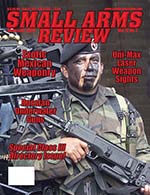By Dan Shea
I know I speak for the rest of the staff here at SAR, as well as “The Usual Suspects,” in thanking the readers for this magazine. It may seem like we bring it to you, but from our point of view, this magazine is reader driven. Each month, we try as hard as we can to bring you reports on the new and exciting, as well as delving deep into some old mysteries. Without your input and requests, we might start running out of ideas, but I simply don’t see that ever happening. Small Arms is a subject of almost infinite depth, and there are new discoveries as well as new additions to the pool of knowledge every day. One walk through almost any small arms museum will yield thousands of stories that need to be told, stories that teach us about some aspect of our martial interest, and one walk through a modern military trade show shows us where the leaders and the movers and shakers are headed.
There’s a lot of traction in the engineering departments at the Majors right now, and some up-and-coming smaller shops with wildcat designers who are experimenting on new technologies as well. As our legacy weapons start reaching the potential end of their life cycles, it is an exciting time to be around small arms design. Our venerable M16 and its offspring have been morphing into new evolutions, and the half century old arch-rival, the Kalashnikov family, have been giving those Stoner grandchildren a run for their money.
It’s exciting every day to see the growth, and to search for the next leap forward. We’ve been enclosing propellant in a thin metallic sheath, popping a primer behind it and forcing a projectile down a rifled bore for over 150 years now. We might do it better, faster and more accurately, but we’re still doing essentially the same thing as our great-grandfathers did. There’s no “Plasma Rifle in the 40-watt range” available over the counter yet, but there sure are some interesting designs being worked on in both the private and the public sector.
SAR, and this author in particular, are long noted for standing up on the soap box in the middle of the room, and ranting about “There’s no substitute for live fire and rounds down range for training” and “It better work without all the accessories, because they get broken or lost.” We’re not old fogies, just being stick-in-the-muds and just trying to ground the discussions. There are some fantastic simulation programs and systems that are in the system today, which have resulted in some excellent training for our troops and officers. There also a host of fantastic accessories, scopes, lasers, thermals, IR, etc, that are saving lives on the battlefield all over the world today. It’s just that those lives do depend on the basic weapon system and those need to be robust and reliable, and they need back up iron sights. On the training, there are a million guys on-line who’ll tell you all the tech specs and theory on a million weapon systems, but taking one to hand is “different.” Also, there is no substitute for carrying live HE grenades on you, and having the awareness and confidence to utilize them under stress.
My point? Simply that we want to see the great leaps forward, we want to also see incremental improvements to the systems in use if they make sense to adopt: but no matter what, we would really like to see the concepts of simple, robust, reliable and accurate kept on the table, as well as lots of rounds down range in training. –Dan
This article first appeared in Small Arms Review V12N2 (November 2008) |
| SUBSCRIBER COMMENT AREA |
Comments have not been generated for this article.



